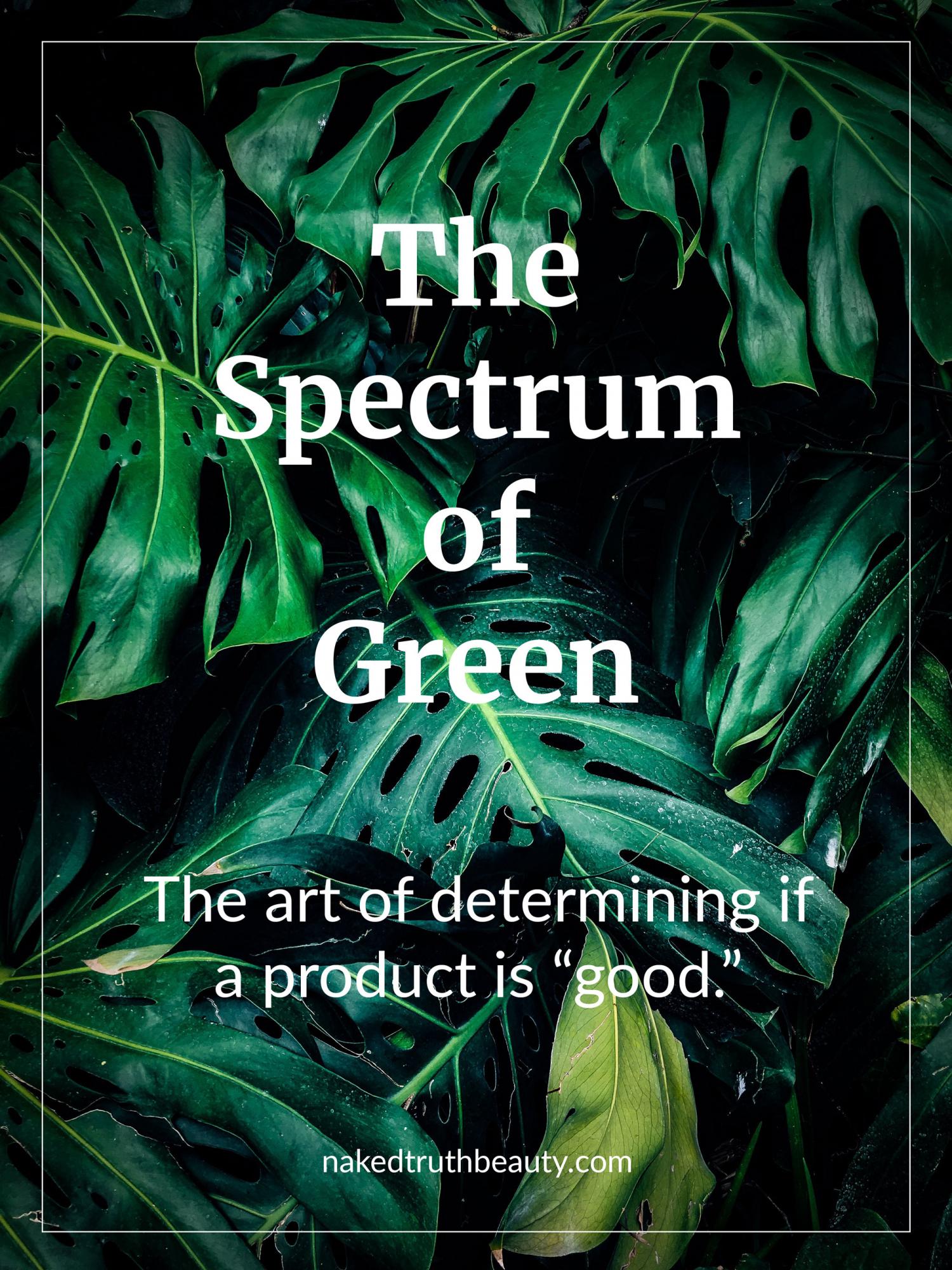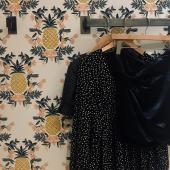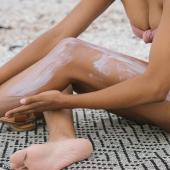The Spectrum of Green
Changing over to "ethical" personal care is a serious undertaking because there's so much information (and about a bazillion products) to wade through. As a result, I'm asked frequently if a given product or brand is "good." (I'm happy to be a resource! Please, keep asking.)
However, this unassuming question is not as simple as it seems. The short answer — as our buddy, Marcel, would say — is "compared to what?" The long answer follows.
The Spectrum of Green™
The healthiness or "green"-ness of a product isn't clear cut. Rather, different components of a product make it better or worse (and for many different reasons), and each product has its own combination of these considerations. As such, I like to refer to products as falling on the Spectrum of Green,© "green" meaning that the brand is trying — at all — to be better for people, communities, the environment, and/or wildlife. The Spectrum goes like this: The closer to "traditional" goods (icky ingredients, unsustainable packaging and ingredients sourcing, etc.) the lighter the green, and the more efforts taken to benefit the aforementioned stakeholders, the darker the green.
The Eye of the Beholder
There are a lot of different considerations that can make a product "good" or "not good," so the answer to the question really lies in what "good" means to the asker.
Thank you, in advance, for understanding how long this list is.
A quick note: It's always okay to ask a brand about something you'd like to know more about — whether that be who owns it, if its suppliers are in the U.S., etc. The worst that can happen is they don't respond or don't provide the answer, and that's its own answer, really.
Health
If the concern is purely for personal health, the field of things to think about narrows considerably, but it's still not black and white.
Even if you're looking only at the impact of the formula's ingredients on human health, an individual's personal risk tolerance is still in the mix. Are you looking for ingredients that are all rated 1 (non-hazardous) on EWG (Environmental Working Group Skin Deep Database), or are you ok with some 3s and 4s so long as they're in low doses that are "generally considered safe?" (Friendly PSA: EWG updated its system over the past few years to change from the former — high/bad number ingredients get you a high/bad number product — to the latter — higher numbers may not drag down…er…up a product rating if the ingredient appears in a low enough dose. They've also begun allowing companies to buy badges. It's not a perfect system, but it's a good resource).
Still, even this doesn't fully cover it. Ingredients get high (less-healthy) ratings for different reasons. Some of these reasons are more concerning – like carcinogenicity or reproductive toxicity – whereas others only get flagged for being a skin and/or eye irritant. It's helpful to know that a product contains a possible irritant in case you're sensitive to something (this gives you a clue that maybe that's the culprit), but you may not be sensitive to it at all, rendering that ingredient, effectively, a 1 (lowest level of hazard).
Inclusivity
This is a much larger topic than this little paragraph, but in an attempt at a brief overview: Inclusivity is a huge issue and a catastrophic failing in beauty. The "clean" beauty space is particularly guilty of being created, owned, and run by — and targeted to — white women. We (as an industry, myself included) have a long way to go to share the mic with Black founders, bloggers, creators, and more, and part of that starts with our buying habits. When evaluating a product of any kind, here are some questions to ask: Who is modeling the products, with faces or body parts (i.e. hands)? Do BIPOC models stand on their own, or are they part of a "we're inclusive" shoot with a member of each race (meaning, does the brand really represent womxn of all backgrounds, or does it look like Tokenism)? For makeup brands, are the shade ranges truly inclusive? Do the home or shop pages only show fair-toned shades? Are a brand's claims of "universality" substantiated? What influencers is the brand working with? Are there a wide range of womxn (or men) of all shades, shapes, and sizes portrayed in brand communications? Who are the founders and does the brand employ BIPOC in leadership roles?
Particularly in the "clean" beauty space, which is infamous for its exclusivity, these are really important questions to consider.
Animals
When it comes to concern for the welfare of animals, it's easy simply to look for a "vegan" or "cruelty-free" label, but this seriously oversimplifies the problem. Please check out my post "When Vegan Cosmetics are Misleading," if you haven't already, but the long story short of it is that just because a product doesn't contain an animal product or wasn't tested on animals, does not mean that no animal was harmed – or will be harmed – by its creation.
Ingredients we use wash off (or go through) our bodies and into the earth and water, contaminating wildlife habitat. There are plenty of ingredients that are vegan and cruelty-free that are also persistent in the environment and toxic to wildlife.
Environmental Impact
Environmental impact comes in the forms of pollution from ingredients (i.e. environmental toxicity, including problems of bioaccumulation and biomagnification), environmental degradation, waste, and carbon footprint.
Environmental Degradation
Even "natural" cosmetics can have negative impacts on the environment. For example, palm oil is ubiquitous in personal care products (and it's a perfectly "healthy" – and efficient from a farming standpoint – ingredient), but it's also a leading cause of deforestation and habitat destruction. As well as having devastating consequences for wildlife, unsustainable farming practices can cause additional damage, such as soil erosion.
Waste
Does the product you're looking at come with excess packaging (think boxes in boxes, plastic wrappings, etc.)? Is the packaging (at all levels) recyclable? If yes, would you be able (and willing) to clean it in order to recycle it? Does your city's recycling system take items of that size (many systems can't take pieces under about 3 inches)? How long does the material take to break down in a landfill? If you're buying it online, does the product come packaged in a sea of plastic?
Good strides in this category come in the form of limited packaging (I'm a big fan of the Ethique shampoo bar), biodegradable packaging (ahem, such as Naked Truth Beauty), or refillable packaging.
Carbon Footprint
A major consideration in this category is sourcing. Does the brand ship heavy glass bottles to the U.S. from China? Are they using specialized ingredients from around the globe? Look for brands who source local ingredients and materials, and/or do work to be carbon neutral.
Sustainable Sourcing
Sustainable sourcing is a complex mix of all of the above environmental concerns, and may include choosing local ingredients, close partnerships with farms or artisan groups or cooperatives, monitoring farming practices, and paying attention to the origins of ingredients.
Ethical Work Environments
This one can be a bit less transparent, but it's a topic that's been (thankfully) getting a lot more attention lately (think Everlane in the fashion world). Who's making the lipstick tube? What about the product itself? Who's growing/harvesting/mining/producing the ingredients? This question comes down to the welfare of the people behind the scenes who are responsible for bringing the product to life.
Yes, it's a lot, but it goes to show that there are a lot of ways a brand can work to be better — to do better. The most important thing is that a brand is trying to be better for people and planet and that the product falls on the Green Spectrum at all.
Remember, you vote with your dollars, and together we can support brands who are working to be the darkest shade of green.

Photo by Aditya Aiyar from Pexels
Copyright © 2020 Naked Truth Beauty, LLC All rights reserved.




